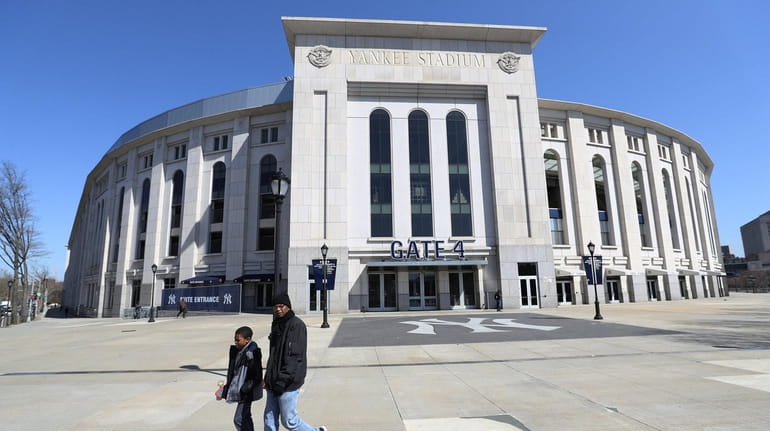Baseball has a great chance to re-establish itself as the national pastime

BRONX, NEW YORK - MARCH 26: A Father and Son walk past a closed Yankee Stadium on the scheduled date for Opening Day March 26, 2020 in the Bronx, New York. Major League Baseball has postponed the start of its season due to the coronavirus (COVID-19) outbreak and MLB commissioner Rob Manfred recently said the league is "probably not gonna be able to" play a full 162 game regular season. (Photo by Al Bello/Getty Images) Credit: Getty Images/Al Bello
The idea of Major League Baseball playing a significant part in the country’s recovery from the COVID-19 outbreak is a concept that’s been gaining momentum recently. Also on the table, however, is a unique but risky chance for the sport to greatly help itself by taking advantage of an unprecedented vacuum in the entertainment world.
“The owners would love the opportunity to be the only professional sport that is around during the summer for people to spend time watching on their televisions when they're locked up in their homes,” said Smith College economics professor Andrew Zimbalist, a nationally renowned authority in the business of sports. “It will give the owners an opportunity I think to re-establish the game in this role with America.
“For the last several decades, they've been slipping out of the position of being the national pastime. Not that they're not prominent — they're still of course very prominent. But I think the opportunity to be the sport that came back for America, in order to give people something to cheer for again, that's a big prize — if they can pull it off.”
Prize is the perfect description, because this is not a solely altruistic exercise, as much as we’re all starving for the live, unscripted drama that sports provides. Senate Majority Leader Mitch McConnell wasn’t wrong the other day in telling Rob Manfred that “America needs baseball” — a conversation McConnell recounted to an ESPN radio station in Louisville — but the flip side is even more accurate.
While there has been a tremendous political push to get sports up and running again — in McConnell’s words, “It’s a sign of getting back to normal” — MLB is now operating in a red-ink revenue world, which includes providing no product for their billion-dollar TV partners.
But if MLB somehow can cobble together a season, even without fans, the broadcast ratings would be off the charts, especially if the NBA and NHL struggle to return.
Look at what happened last weekend, when the NFL staged its first virtual draft, moving the event’s location from the majestic Bellagio in Las Vegas to Roger Goodell’s man cave in Westchester County. This basically amounted to the NFL commissioner reading off a list of names from his basement (with Zoom fans cheering on his big screen), and yet it was broadcast on a handful of channels that generated staggering viewership.
Despite this rather mundane exercise, with a player’s highlight reel sprinkled in, the NFL Draft averaged a record 15.6 million viewers over three nights, including a peak of 19.6 million, obliterating last year’s 11.4 million apex. By comparison, Game 1 of the 2019 World Series drew 12.2 million viewers. The 2019 NBA Finals opener attracted 13.6 million.
Obviously, fan attendance is huge for MLB. Teams get 40 to 50% of their income from gate revenues, which include ticket sales, concessions, parking and sponsorships. But as leagues continue to search for other money-making streams, this potentially lengthy window of empty ballparks and arenas will force sports to expand those efforts.
MLB’s multi-media branches have been very successful earners, but there are other untapped sources that many of us hadn’t imagined before this pandemic.
“It clearly will be changed,” said Vince Gennaro, associate dean at NYU’s Tisch Institute for Global Sport. “The revenue streams today are much more diversified than they were 25 years ago in terms of when it was so heavily dependent on live attendance. I think we're going to see an acceleration of that. I think 2030 will get here in 2025. Wherever we would have been in 2030 will probably come five years sooner out of necessity. We will be spurring this and moving this innovation forward and coming up with new business models that monetize fan passion for sport.”
Overseas, Taiwan’s professional baseball league — already underway — began playing in front of fan cutouts and mannequins but plans to phase in fans gradually. The Korean Baseball Organization (KBO) will open Tuesday with empty stadiums but also hopes to allow spectators on a limited scale.
Here in the U.S., we’re still too far behind their COVID-19 efforts at this point to seriously be considering fans in the building, but that shouldn’t stop MLB from devising ways to partially make up for the missing attendance, which already had been on a downward trend in recent years.
“Now it's going to be a scramble to figure out the new revenue streams,” Gennaro said. “How to augment the existing ones and develop new ones, like selling a virtual season ticket. Like behind the Mets' dugout, a seat with a virtual-reality view of the ballpark. You can sell that around the globe. You don't have to sell that just in the 90-mile radius around Citi Field.”
“The technology has to be refined and finished, but it's close. I think those are the kinds of things that will take up some of the slack. But I think eventually we'll get to a point where we will create a whole structure around delivering the game to fans at remote locations in all sorts of innovative ways.”
MLB has more immediate obstacles in getting the game back on the field. One was settled Friday in agreeing to reduced compensation for the umpires. On deck is negotiating a payment plan for the players. That will be much more difficult. But if the virus can be controlled — again, a big if — the potential reward for baseball’s return should be motivation enough to iron out the details.

